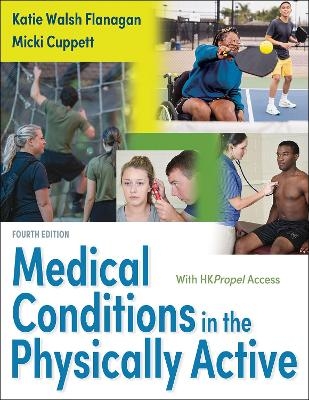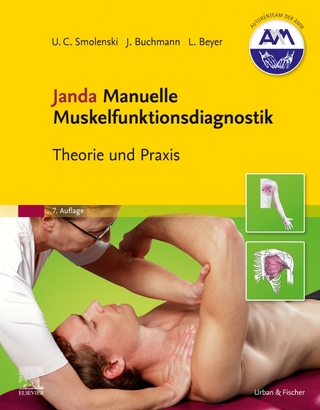
Medical Conditions in the Physically Active
Human Kinetics (Verlag)
9781718215405 (ISBN)
Medical Conditions in the Physically Active, Fourth Edition With HKPropel Access, assists athletic trainers and other allied health care providers in recognizing and identifying medical conditions in athletes and active individuals. The book addresses medical conditions by body system, their mechanism of acquisition, signs, symptoms, differential diagnoses, referral, treatment, return-to-participation criteria, and potential comorbidities.
Previously titled Medical Conditions in the Athlete, this fourth edition uses current research to offer assessment and treatment information for medical conditions that affect both athletes and active populations. The highly esteemed authors, Katie Walsh Flanagan and Micki Cuppett, have combined their professional skills and educational expertise to create a valuable athletic training resource with updated content that aligns with Board of Certification (BOC) and Commission on Accreditation of Athletic Training Education (CAATE) standards. The fourth edition offers the following updates:
A new section on acute respiratory illnesses, including COVID-19 and SARS
A new section on gastrointestinal disorders
A new chapter on endocrine disorders
Expanded content on concussion detection, treatment, and management, including return to play guidance
New photos presenting medical conditions on diverse skin colors to help students learn identification skills
Two to four case studies per chapter, delivered through HKPropel, to provide students with real-world examples; the case studies include multiple-choice questions that are assignable and automatically graded
The book is organized into three sections-Introduction to Medical Conditions, Pharmacology and Interventions, and Medical Conditions by System-and there are 18 comprehensive chapters. Throughout the text, more than 350 full-color illustrations and photographs visually enhance readers’ comprehension of anatomy, physiology, and pathophysiology. Pharmacological tables organize drugs by categories that include generic and trade names, therapeutic uses, adult dosage information, and possible adverse effects. Important terminology is highlighted throughout the chapters, and a glossary appears at the end of the text. Chapter objectives and chapter summaries assist students in finding key information. Chapter quizzes, which are automatically graded, may also be assigned to test comprehension of critical concepts.
At the beginning of the text, a Condition Finder serves as a quick reference so students or clinicians can easily flip to the information they need on specific conditions. Throughout the book, Red Flags for Urgent Intervention offer warning signs that health care providers should look for when working with patients; Clinical Tips discuss information that is critically important to professionals; and Condition Highlights cover specific medical conditions common to athletes and the physically active that require special attention or medical care.
Medical Conditions in the Physically Active, Fourth Edition With HKPropel Access, provides comprehensive medical information to help readers build a framework for decision making that will help them choose effective courses of treatment.
Note: A code for accessing HKPropel is included with this ebook.
Katie Walsh Flanagan, EdD, LAT,ATC, is a professor in the department of health education and promotion at East Carolina University (ECU), where she has worked for over two and a half decades, and is a certified athletic trainer by the Board of Certification (BOC). She was hired in 1995 as director of the sports medicine and athletic training program at East Carolina University; served as a lecturer and assistant athletic trainer at California State University, Fresno; and served as the head athletic trainer for the Chicago Power, a men’s professional soccer team. She has also assisted as an athletic trainer for various sports in international competitions, including the 1996 Summer Olympic Games and the 1987 Pan American Games. Flanagan is a practicing athletic trainer and has volunteered in ECU Athletics for the past 28 years. In 2012, Flanagan was elected to the North Carolina Athletic Trainers’ Association Hall of Fame. The organization named her the College/University Athletic Trainer of the Year in 2000 and 2006. In 2023 she was elected to the Mid-Atlantic Athletic Trainers’ Association Hall of Fame. She received the National Athletic Trainers’ Association (NATA) Most Distinguished Athletic Trainer Award in 2010 and NATA’s Service Award in 2006. In 2017, she was named a NATA board member as the director of District Three, where she served until 2022. Flanagan is an author of three medical textbooks and a prolific speaker on athletic emergencies and on weather and safety policies. Micki Cuppett, EdD, LAT, ATC, FNAP, has more than 30 years of experience as an athletic trainer, medical educator, and administrator. She has directed athletic training programs at two universities, both at the undergraduate and graduate levels. In addition to educating athletic training students, Micki also taught medical, nursing, physical therapy, and pharmacology students in the University of South Florida College of Medicine and helped initiate the interprofessional education program. She is now a consultant in the areas of strategic planning, interprofessional education, leadership, accreditation, AT education, medical simulation, and innovation. Prior to starting her own consulting business, Cuppett was the executive director for the Commission on Accreditation of Athletic Training Education (CAATE). During her tenure in the position, she oversaw the successful recognition of CAATE by the Council for Higher Education Accreditation, converted all accreditation documentation and processes to an electronic platform, and implemented an entirely virtual office. She is a fellow of the National Academies of Practice and the USF Health Leadership Institute. Cuppett has received numerous professional awards and hall of fame inductions throughout her professional career.
Part I. Introduction to Medical Conditions
Chapter 1. Medical Examination
Examination of the Patient With a Medical Condition
Physical Examination
Summary
Chapter 2. Diagnostic Imaging and Testing
Radiography: X-Rays
Radionuclide Bone Scan
Fluoroscopy
Computed Tomography Scan
Positron Emission Tomography Scan
Magnetic Resonance Imaging
Diagnostic Ultrasound
Laparoscopy
Colonoscopy
Endoscopy
Electromyography and Nerve Conduction Studies
Electrocardiography
Cardiac Event Monitor
Cardiac Stress Test
Urinalysis
Complete Blood Count
Lumbar Puncture
Pulse Oximeter
Summary
Part II. Pharmacology and Interventions
Chapter 3. Basic Principles of Pharmacology
Regulation of Pharmaceuticals
Pharmacology
Special Considerations for Athletes
Potential Drug Misuse
Supplements
Resources
Summary
Chapter 4. Drug Categories
Anti-Inflammatory Agents
Narcotic Analgesics
Local Anesthetics
Antibiotics
Antivirals
Antifungals
Bronchodilators
Antihistamines
Decongestants
Gastrointestinal Disorders
Antidiabetic Agents
Biologics
Supplements
Summary
Chapter 5. Common Procedures in the Athletic Training Clinic
Informed Consent
Preventing Infection
Asepsis and Aseptic Technique
Procedures Used to Close Lacerations
Joint Aspiration and Injection
Summary
Part III. Medical Conditions by System
Chapter 6. Respiratory System
Overview of Anatomy and Physiology
Evaluation of the Respiratory System
Asthma and Exercise-Induced Bronchospasm
Acute Respiratory Illnesses
Upper Respiratory Infections
Bronchitis
Chronic Obstructive Pulmonary Disease
Pneumonia
Pleurisy
Spontaneous Pneumothorax and Hemothorax
Tuberculosis
Lung Cancer
Summary
Chapter 7. Cardiovascular System
Overview of Anatomy and Physiology
Cardiovascular Adaptations to Exercise
Preparticipation Examination
General Evaluation of the Cardiovascular System
Sudden Cardiac Death
Hypertrophic Cardiomyopathy
Coronary Artery Abnormalities
Marfan Syndrome
Myocarditis
Congenital Aortic Stenosis
Mitral Valve Prolapse
Arrhythmias
Syncope
Hypertension
Deep Vein Thrombosis
Pulmonary Embolus
Peripheral Arterial Disease
Anemia
Hemolysis
Sickle Cell Trait or Sickle Cell Anemia
Summary
Chapter 8. Gastrointestinal System
Overview of Anatomy and Physiology
Evaluation of Abdominal Pain
Evaluation of the Athlete With Acute, Traumatic Abdominal Pain
Nausea, Vomiting, and Diarrhea
Viral Gastroenteritis
Food Poisoning or Bacterial Diarrhea
Parasitic Infection
Stress-Induced Gastrointestinal Symptoms
Constipation
Heartburn and Gastroesophageal Reflux Disease
Gastritis and Peptic Ulcer Disease
Irritable Bowel Syndrome
Celiac Disease
Inflammatory Bowel Diseases
Appendicitis
Cholecystitis and Cholelithiasis
Colorectal Cancer
Summary
Chapter 9. Genitourinary and Gynecological Systems
Overview of Anatomy and Physiology
Evaluation of the Genitourinary and Gynecological Systems
Kidney Stones
Sports Hematuria
Urinary Tract Infection
Urethritis and Cystitis
Human Immunodeficiency Virus and Acquired Immunodeficiency Syndrome
Genital Warts
Syphilis
Gonorrhea
Chlamydia
Testicular Torsion
Hydrocele
Varicocele
Testicular Cancer
Prostate Cancer
Vaginitis
Pelvic Inflammatory Disease
Dysmenorrhea
Amenorrhea
Mittelschmerz
Ovarian and Cervical Cancer
Breast Cancer
Pregnancy
Ectopic Pregnancy
Summary
Chapter 10. Neurological System
Overview of Anatomy and Physiology
Evaluation of the Neurological System
Pathological Conditions
Sport-Related Concussion
Stroke
Headaches
Seizure Disorder and Epilepsy
Vertigo
Amyotrophic Lateral Sclerosis
Bell’s Palsy
Rabies
Complex Regional Pain Syndrome
Summary
Chapter 11. The Eye
Overview of Anatomy and Physiology
Evaluation of the Eye
Refractive Error
Conjunctivitis
Corneal Abrasions
Corneal or Scleral Lacerations
Corneal and Conjunctival Foreign Bodies
Hyphema
Subconjunctival Hemorrhage
Eyelid Lacerations
Orbital Fracture
Retinal Tear and Detachment
Dislocated Contact Lens
Chemical Burns
Periorbital Contusion
Traumatic Iritis
Proptosis
Protective Eyewear
Summary
Chapter 12. Ear, Nose, Throat, and Mouth
Overview of Anatomy and Physiology
Evaluation of the Ear, Nose, Mouth, and Throat
Hearing Loss
Otitis Externa
Otitis Media
Ruptured Tympanic Membrane
Allergic Rhinitis
Nonallergic Rhinitis
Sinusitis and Rhinosinusitis
Deviated Septum
Epistaxis
Pharyngitis and Tonsillitis
Laryngitis
Oral Mucosal Lesions
Oral Candidiasis
Oral Cancers
Dental Disease
Dental Caries
Summary
Chapter 13. Systemic Disorders
Overview of Anatomy and Physiology of the Lymphatic System
Non-Hodgkin’s Lymphoma
Hodgkin’s Lymphoma
Leukemia
Lyme Disease
Raynaud’s Disease
Systemic Lupus Erythematosus
Fibromyalgia
Chronic Fatigue Syndrome
Multiple Sclerosis
Guillain-BarrÉ Syndrome
Gout
Pseudogout
Rheumatoid Arthritis
Osteoarthritis
Osteomyelitis
Polymyositis and Dermatomyositis
Summary
Chapter 14. Infectious Diseases
Prevention of Disease Transmission
Transmission
Prevention
Influenza
Infectious Mononucleosis
Mumps
Rubeola
Rubella
Chicken Pox and Shingles
Hepatitis A to D
Streptococcal Infections
Staphylococcal Infections
Sexually Transmitted Diseases and Infections
Encephalitis
Zika Virus
Viral Meningitis
Acute Bacterial Meningitis
Summary
Chapter 15. Endocrine Disorders
Pancreatitis
Diabetes Mellitus
Hyperthyroidism
Hypothyroidism
Summary
Chapter 16. Dermatological Conditions
Overview of Anatomy and Physiology
Evaluation of the Skin
Urticaria
Dermatographism
Cholinergic Urticaria
Cold Urticaria
Solar Urticaria
Epidermoid Cysts
Eczema and Atopic Dermatitis
Psoriasis
Skin Cancer
Frostbite
Impetigo
Folliculitis
Furuncles and Carbuncles
Acne
Paronychia or Onychia
Herpes Simplex
Varicella-Zoster
Molluscum Contagiosum
Human Papillomavirus
Tinea Corporis
Tinea Cruris
Tinea Unguium
Tinea Pedis
Tinea Capitis
Tinea Versicolor
Head Lice
Body Lice
Pubic Lice
Scabies
Insect Bites
Summary
Chapter 17. Psychological and Substance Use Disorders
Layne A. Prest
Understanding the Role of Mental Health Professionals
Overview of Mental Health Issues in the Athlete
Role of Stress in Psychological and Substance Use Disorders
Anxiety Disorders
Mood Disorders
Eating Disorders
Substance Use and Dependence
Attention Deficit Hyperactivity Disorder
Stages of Readiness
What to Do in a Crisis
Summary
Chapter 18. Working With Special Populations
Preparticipation Examination for Athletes With Disabilities
Overview of Anatomy and Physiology
Traumatic Tetraplegia and Paraplegia
Autonomic Dysreflexia
Boosting
Thermoregulation Concerns
Skin Breakdown and Pressure Sores
Spasms
Bladder Dysfunction
Spina Bifida
Poliomyelitis
Cerebral Palsy
Amputations
Sensory Disabilities
Intellectual Disabilities
Summary
| Erscheinungsdatum | 17.04.2024 |
|---|---|
| Verlagsort | Champaign, IL |
| Sprache | englisch |
| Maße | 216 x 279 mm |
| Gewicht | 1520 g |
| Themenwelt | Sachbuch/Ratgeber ► Sport |
| Medizin / Pharmazie ► Medizinische Fachgebiete ► Sportmedizin | |
| Medizin / Pharmazie ► Pflege | |
| Medizin / Pharmazie ► Physiotherapie / Ergotherapie | |
| ISBN-13 | 9781718215405 / 9781718215405 |
| Zustand | Neuware |
| Informationen gemäß Produktsicherheitsverordnung (GPSR) | |
| Haben Sie eine Frage zum Produkt? |
aus dem Bereich


